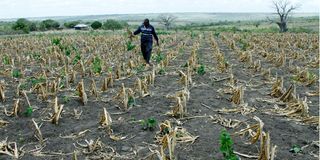Too much taken, too little time for earth to replace: Kenya in trouble

A farmer at Kamale area in Magarini, Kilifi County last year. Crops had failed due to unfavourable weather conditions.
What you need to know:
- Kenya has been listed among countries that are using Mother Nature’s resources faster than the earth can replenish them.
- In 1961, for instance, Kenya’s land could regenerate resources from 2.7 million hectares of cropland for every 2.6 million hectares used.
- However, by 1997, when humans were using 6.1 million global hectares, the earth had the capacity to regenerate 5.3 million.
Kenya has been listed among countries that are using Mother Nature’s resources faster than the earth can replenish them.
A report by the Global Footprint Network (GFN) says that Kenya has progressively, since 1961, used more of her resources – including cropland, fishing grounds, forest products and grazing land – more than she can regenerate.
This has been occasioned by population explosion that has put pressure on available resources, with the demand exceeding the supply.
In 1961, humankind could access more resources because of a smaller population. However, at the moment, the rising population – which has led to an increased demand for resources – also competes for the same resources that the earth struggles to replenish.
In 1961, for example, Kenya’s land could regenerate resources from 2.7 million hectares of cropland for every 2.6 million hectares used. However, by 1997, when humans were using 6.1 million global hectares, the earth had the capacity to regenerate 5.3 million. By 2018, when Kenyans used 13.7 million hectares of resources, the earth could only regenerate 10.2.
For every 41, 829 hectares of fishing grounds used in 1961, the earth could regenerate 838,181 hectares. However, that changed over the years, remarkably in 1990, where Kenya used up 2.7 million hectares when the earth could only regenerate 802, 960.
By 2018, with reduced reserves in fishing grounds due to overfishing, Kenya was using up 1.2 million hectares, when its portion on earth could replace 801,568.
Overall, in 1961, a Kenyan only needed 2.15 global hectares to survive and thrive, and the earth could replenish 1.8 hectares.
But 47 years later, this has gone down to one hectare with the earth only able to replace only 0.47 due to increased competition for resources.
In 1961, the country’s population needed 17.9 million global hectares of resources, when the earth could replace 15 million hectares. As of 2018, the increased population had demanded for more resources, raising the country’s ecological footprint to 51. 5. However, the earth now has 24-million-hectare capacity to replace these resources.
This year, Earth Overshoot Day – which marks the date when humanity has used all the biological resources that earth regenerates during the entire year – fell on July 28.
The entire world is, until December, living on credit. The date is arrived at by dividing the amount of ecological resources the earth is able to generate that year by humanity’s demand for that year. This ratio is then multiplied by 365.
“Overshoot is driven by the amount of resources consumed, how efficiently products are made, human population and how much nature’s ecosystems are able to produce. And even though technology and more intensive inputs have helped expand biological productivity over the years, the expansion has not come close to keeping pace with the rate at which population and resource demand have expanded,” notes GFN.
“Data shows that both the world population and consumption are increasing, leaving a smaller pool of resources for everyone. Larger populations mean finite resources must be divided among more people. Whatever the factors, humanity is simply demanding more than the earth can provide. This overuse cannot be maintained for long,” they add.
“If we continue on the course estimated by moderate United Nations projections for increasing population and consumption, we would need the capacity of two Earths to keep up with our level of demand by 2030,” adds GFN.
Besides, the network notes that more than three billion people in the world live in a country that produces lesser amounts of food than the amount consumed by their country’s population. Their income per person is also lower than the global average.
This, therefore, means that countries with high relative income can easily purchase food in international markets and import them. Because lower income countries have less leverage, they run a higher risk of food insecurity.
An increase in food security was already identified by the United Nations, who noted that 828 million people were affected by hunger in 2021, which translates to 46 million people more from a year earlier and 150 million more from 2019.
“Almost 3.1 billion people could not afford a healthy diet in 2020, up 112 million from 2019, reflecting the effects of inflation in consumer food prices stemming from the economic impacts of the Covid-19 pandemic and the measures put in place to contain it,” said The State of Food Security and Nutrition in the World report.
Solutions, says the network, can be sought through managing green spaces, cities, energy, food, and population. This includes restoring land through afforestation to cut carbon dioxide, new ways of farming to ensure soil productivity, sustainable fishing to support overall ocean health.
“Overall ocean health helps ensure that the ocean continues to provide for generations to come. Approximately three billion people rely on seafood as their primary source of protein, especially in low-income countries. A healthy ocean also needs acidification to be slowed by controlling carbon emissions, since the ocean currently absorbs 30 percent of our carbon emissions,” GFN advises.
Since at least 70 percent of all people are expected to live in urban areas by 2050, GFN recommends smart city planning and urban development to ensure that excessive human demand is prevented.



